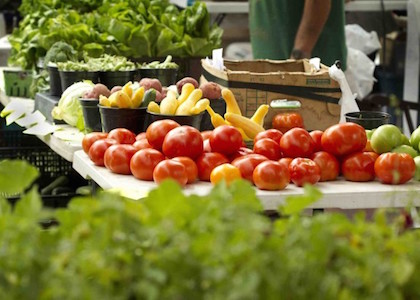
Why Go Local?
By Stacy Kennedy, MPH, RD, CSO, LDN; Reboot Nutritionist
Earth Day is a perfect time to connect back to our roots and think about shifting to a more locally plant-based diet. Eating locally is good for the planet and is quickly becoming the new mantra for health connoisseurs. Whether you already consider yourself a “locavore” or are simply curious about the growing movement, this post will shed light on why local foods are the most nutritious and easy tips for how to eat locally.
Why go local?
Have you ever noticed that farm fresh lettuce is a brighter green, tomatoes are a more vibrant red and both are much more flavorful than bagged salads you get from the supermarket? This freshness we can see, smell and taste signals not only a more delicious salad, but a much more nutritious one as well. Many of the health promoting properties of produce are concentrated in their pigment or pungency.
Eating local foods means that the time from when the produce was picked to the time it reaches your plate is much shorter. In the off-season it’s rather common to find organic apples here in Boston that have traveled all the way from Chile or New Zealand to Massachusetts. In fact the USDA Economic Research Service reports that about 40% of the fruit we consume in the US is grown overseas. While organic apples are considered a better choice than conventional because of pesticide residue, traveling across the globe, organic or not, will still result in a less nutrient dense apple compared to a local apple. Estimates show that here in the US, on average, produce found at a grocery store, even if it was grown in the States, has traveled approximately 1,500-1,800 miles from the farm to your home.
It is important to keep in mind that the term “organic” is not a fail-safe guarantee that your produce is 100% free of pesticides, or more importantly just because a fruit or vegetable is not labeled as “organic” doesn’t mean it is seething with toxins. Since the organic stamp of approval has become popular, this certification process has become very expensive. Some local farms have amazingly sound, healthy and safe farming practices but simply can’t afford the process to gain the organic stamp of approval. Speak with your local grower to find out how they grow their crops and let that guide you in deciding if a sustainably farmed apple grown without pesticides from just down the road is actually a healthier choice than that apple from overseas boasting an organic sticker.
The reasons for considering local sources for your food extend far beyond their nutritional value. Buying local food is a way of actively supporting your community. Many family farms are struggling to stay afloat in this economy, and they are an important part of maintaining a secure source of healthy foods for us and for generations to come.
If you want to get really local, consider growing produce at home. Even if you don’t have a garden, window boxes for herbs or wheat grass or claiming a spot in an urban farm are just a few ideas for keeping your fruits and veggies close to home.
Including local foods can be simple, quick and delicious. Springtime has arrived in the US offering a healthy selection of vegetables including asparagus, fiddleheads, fava beans, parsley, spinach, rhubarb, and lettuce.
Spring Food Spotlight: Parsley
Parsley has a long history of use as a breath freshener and is a prominent feature in Mediterranean diets. The Mediterranean diet and lifestyle is associated with a lower risk for developing heart disease, diabetes and certain types of cancers. Parsley contains numerous phytonutrients and vitamins such as folic acid, which is important for healthy red blood cells and a lower risk of certain cancers. Parsley is a great addition to your favorite green juice. It is flavorful, vibrant and a very cost effective veggie. Save your leftover parsley pulp for making a yummy broth or as a topping for any green salad.
Looking for more information about local foods, community gardens, urban farming, CSA, gardening, and preserving your fresh summer produce for winter?